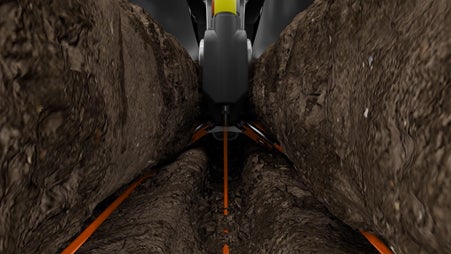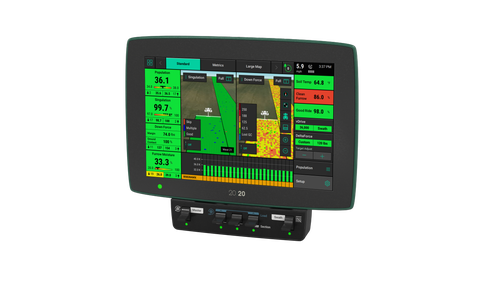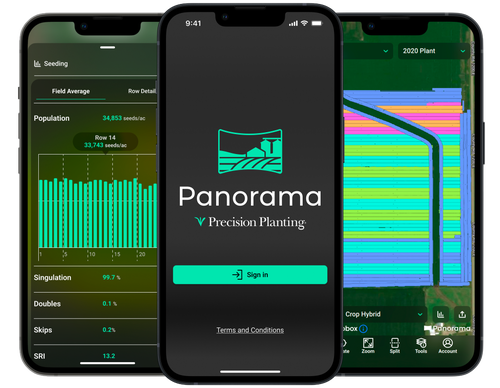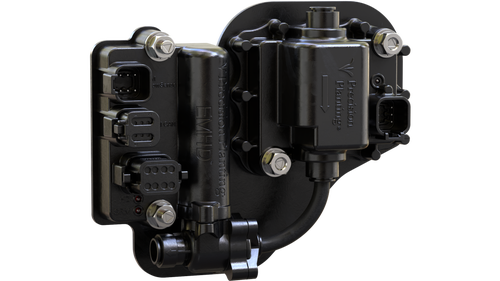Going in Blindfolded
After several years of applying liquid fertilizer on his planter, Fred is looking for more control.
He has upgraded his fertilizer placement unlike his neighbor, “Dump All in the Fall Ted,” who simply broadcasts 100% of his fertilizer. Now that Fred applies fertilizer in-furrow with FurrowJet, his plants are getting a stronger start with a quicker drink of starter. However, he can't see what's actually being applied and wants a little more control.

FurrowJet firms the seed in the trench and then places bands of fertilizer through the center of the firmer, 3/4" away from the seed on either side, or all of the above.
The FurrowJet system he installed a few years back through the Fertilizer Partner Program is helping firm and fertilize each plant, but he’s noticed areas where he wasn’t applying what he was expecting to, causing plant health and yield variability.
Fred’s planter is a 16-row John Deere 1775NT CCS with ExactEmerge row units. While he’s happy with his planter, he’s starting to wonder what his application rates really are as he bounces across the field. Fred has never used a 20|20 in the cab, but overheard some local farmers talking about how beneficial it can be to have that real-time information right in front of your face.
He thinks he’s putting down the right amount across the field, but how can he be so sure?
Gaining 20|20 Vision
To Fred, it’s worth looking into a system that can monitor and control fertilizer placement, but only if the benefits outweigh the cost.
He decided to reach out to his Precision Planting Premier Dealer to see what he could add to his existing planter (without breaking the bank) to get more visibility and consistency across the board.
Fred’s Premier Dealer recommended the 20|20 Planter Base System for a cost of $19,0001, building the base for monitoring and gathering agronomic data.
To address the inconsistency in his fertilizer application rates, Fred also decided to invest in EMHD to control his fertilizer rates on each row. With EMHD, Fred has more flexibility over the liquid products he’s putting down and the individual row rates.
EMHD is robust against debris and performs well with most grades of liquid fertilizer. The modules can also be configured in either section control or row-by-row control to apply the correct rate.
With row-by-row control and turn compensation, Fred can speed up, slow down, and turn without restriction while EMHD determines what each row needs at every point within the field and ensures a consistent application rate across the planter. Moving to a system with individual row control provides Fred with improved accuracy on plant-to-plant fertilizer rates, addressing underapplication and variability issues he saw previously with planter wide rate control.
Fred's row-by-row rate variability was all over the board before EMHD. Now, he's ensured an even rate on every row, in every pass and every field.
Fred is also utilizing liquid prescription maps for the first time, ensuring the correct amount of fertilizer needed is delivered at each point throughout the field.
With the 20|20 in the cab, he can now see his real-time application data and the true payoff of his investment.
So do the benefits really outweigh the cost?
With the liquid control system coming in at $20,0002, this year’s upgrades cost Fred a total of $39,000 but the list of benefits is extensive:
- Visibility to individual row application rates
- Flexibility in choice of viscosity of fertilizer products
- Control over individual row application rates
- Uniformity in application across every acre
- Confidence in not over or under applying on point rows and when turning
- Ability to leverage prescription maps for added rate accuracy
- Uniform crop stands
- Increased yields
- Fertilizer cost savings
- Peace of mind that the planter is performing how it was meant to
We’ll let you do the math.
A Tiered Approach
There are intermediate options to customize your planter's liquid system. If individual row control is not for you, you can still take advantage of liquid monitoring and control at a lower price point.
Monitoring Only: Use Flowsense alone to measure applied rate row-by-row
Adding Control: Rate control module provides planter-wide rate control that can be measured with Flowsense on each row
Investing in monitoring and control at the planter-wide or section level can provide a lower cost entry point with the ability to upgrade in the future.
Which Upgrade is Next?
Now that Fred can see his field data with the 20|20 monitor, his planter has more potential.
Adding more Precision Planting products could make his yields exponential!
Which would you add first?
- SmartFirmer » Soil Moisture Sensors
- vDrive » Electric Drives
- DeltaForce » Automated Downforce
- SmartDepth » Automated Depth Control
- SpeedTube » High Speed Planting
- FurrowForce » Automated Closing
1 Cost is estimated for a 2010 1770NT CCS John Deere Planter using 2025 pricing. Pricing may not include installation.
2 Cost is estimated for a 2010 1770NT CCS John Deere Planter that is already equipped with a 20|20 Planter Base System (Gen 3 20\20, SRMs on each row, necessary wiring harnesses and load pins) using 2025 pricing. Pricing may not include installation.
Prices are subject to change. Contact your local Precision Planting Premier Dealer for a free quote.






